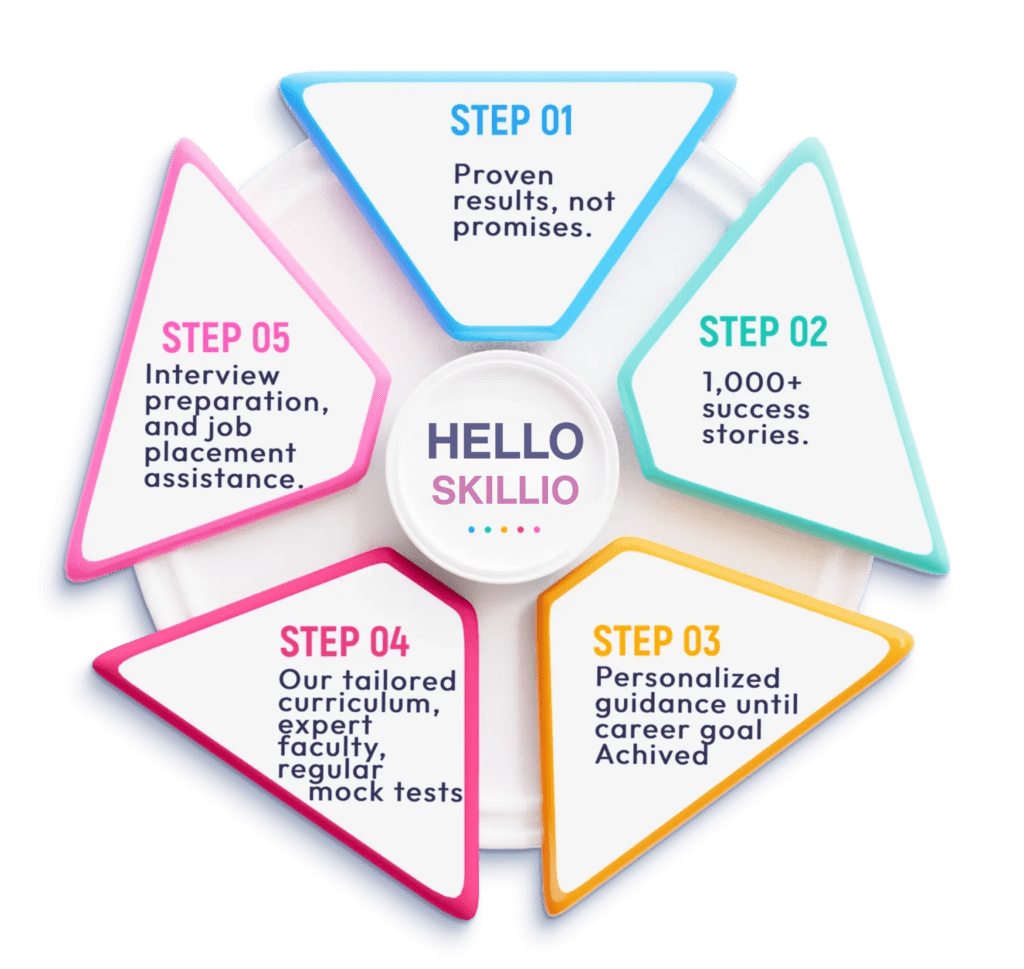In today’s fast-evolving tech world, writing code is more than just making software work — it’s about writing clean, efficient, and scalable code that others can easily understand and maintain. Whether you’re a beginner learning your first programming language or a professional working on complex projects, Get answer of What Are the Best Coding Practices for Developers? in following content and ensures your code stands the test of time.
At HelloSkillio, known as the Best IT Training Institute in Pune, we believe that great developers are not just good at solving problems — they are disciplined, consistent, and follow proven coding standards.
Let’s dive into the top coding practices that every developer should master in 2025.
1. Write Clean and Readable Code
Clean code is the foundation of every successful project. It’s not about how clever your code looks; it’s about how easily others can understand it.
Key points to remember:
- Use meaningful variable, class, and function names.
- Maintain consistent indentation and spacing.
- Avoid overly complex logic — simplicity is powerful.
- Write small functions that do one thing well.
Readable code helps your teammates (and your future self) quickly grasp what’s happening without re-deciphering your logic months later.
2. Follow Consistent Naming Conventions
Naming conventions bring order to your codebase. Developers across teams can easily navigate through your code when everything follows a predictable pattern.
For example:
- Use camelCase for variables and functions in JavaScript (userName, getUserData()).
- Use PascalCase for classes (UserProfile, ProductManager).
- Keep naming consistent throughout your project.
Consistency prevents confusion and creates harmony in collaborative development environments.
3. Comment with Purpose
Comments should add value — not restate the obvious. The best comments explain why something is done, not what is done.
Bad comment:
i++; // increment i by 1
Good comment:
// Increase retry count to limit API request attempts
i++;
Use comments to describe complex algorithms, business logic, or any unusual decisions made in your code. However, don’t overdo it — too many comments may clutter your file.
4. Keep Your Code DRY (Don’t Repeat Yourself)
Repetition is a major source of bugs and inefficiency. The DRY principle encourages reusability and modularity.
Instead of copying and pasting similar code multiple times, refactor it into:
- Reusable functions or methods
- Common utility files
- Reusable components (especially in frameworks like React or Angular)
This ensures that if you need to make a change, you only have to do it in one place.
5. Use Version Control Wisely
Version control systems like Git are essential tools for modern developers. They help manage code versions, collaborate effectively, and roll back to previous states when needed.
Follow these best practices with Git:
- Commit small, meaningful changes frequently.
- Write clear, descriptive commit messages.
- Use branches for new features or bug fixes.
- Merge only after proper testing.
Version control is your safety net — use it smartly.
6. Follow the SOLID Principles
If you’re working in object-oriented programming (OOP), the SOLID principles are essential for designing robust, maintainable systems:
- S: Single Responsibility Principle
- O: Open/Closed Principle
- L: Liskov Substitution Principle
- I: Interface Segregation Principle
- D: Dependency Inversion Principle
Together, these principles make your software flexible and less prone to bugs.
7. Optimize Code for Performance
Efficient code doesn’t just work — it works fast. Optimize wherever possible:
- Avoid unnecessary loops or nested functions.
- Use appropriate data structures (e.g., hash maps instead of arrays for fast lookups).
- Reduce API calls or database queries.
- Profile and test your code to find bottlenecks.
Performance optimization ensures that your applications scale smoothly and provide a better user experience.
8. Test Your Code Regularly
Testing should be an integral part of your development process, not an afterthought. Unit testing, integration testing, and end-to-end testing all play crucial roles in maintaining code quality.
Popular testing frameworks:
- JavaScript: Jest, Mocha
- Python: PyTest, Unittest
- Java: JUnit, TestNG
Automated tests catch issues early, reduce debugging time, and build confidence in your codebase.
9. Maintain Proper Documentation
Comprehensive documentation bridges the gap between developers and future maintainers. A well-documented project helps others quickly understand how to use, modify, or extend your system.
Good documentation includes:
- Project overview
- Installation instructions
- API references
- Code examples
Use tools like Markdown or Docusaurus for clear and structured documentation.
10. Secure Your Code
Cybersecurity is more important than ever. Developers should be proactive about writing secure code to protect applications from vulnerabilities.
Security practices to follow:
- Validate all user inputs.
- Use parameterized queries to prevent SQL injection.
- Avoid storing plain text passwords.
- Keep dependencies up to date.
- Regularly perform code audits and penetration tests.
A secure codebase builds trust and reliability.
11. Code Reviews Are Essential
Code reviews ensure quality control and continuous learning among teams. They help detect bugs, maintain consistency, and encourage collaboration.
Benefits of code reviews:
- Early error detection
- Improved readability
- Knowledge sharing among team members
- Encouragement of best practices
Always be open to feedback — good developers grow through peer insights.
12. Use Automation Tools
Automation enhances efficiency and consistency across development workflows.
Examples of automation tools:
- CI/CD pipelines: Jenkins, GitHub Actions
- Code formatters: Prettier, Black
- Linting tools: ESLint, Pylint
Automation reduces manual effort and ensures every deployment is smooth and error-free.
13. Refactor Regularly
Codebases evolve, and so should your code. Refactoring improves existing code without changing its behavior, making it cleaner and more maintainable.
When to refactor:
- When code smells (too complex, duplicated logic)
- Before adding new features
- After a major release
Refactoring is not optional — it’s part of responsible coding.
14. Keep Learning and Stay Updated
The tech industry evolves at lightning speed. New frameworks, languages, and tools emerge every year. To stay relevant:
- Follow coding communities on GitHub, Reddit, and Stack Overflow.
- Take advanced courses like a Full Stack Developer Course in Pune to sharpen your skills.
- Attend webinars, coding bootcamps, and hackathons.
Continuous learning is the hallmark of a great developer.
15. Practice Collaboration and Communication
Great code doesn’t exist in isolation. Developers often work in teams — clear communication ensures everyone is aligned.
Collaboration tips:
- Use project management tools like Jira or Trello.
- Conduct regular stand-up meetings.
- Share knowledge through documentation or internal workshops.
Strong teamwork leads to stronger codebases and faster delivery cycles.
Conclusion
Becoming an excellent developer isn’t just about mastering programming languages — it’s about adopting the best coding practices that make your work cleaner, faster, and more maintainable. From writing readable code to ensuring security and testing, every step matters.
At HelloSkillio, recognized as the Best IT Training Institute in Pune, our courses are designed to not only teach programming but also instill these best practices from day one. By following these coding principles, you’ll be better prepared for real-world projects and career success in the IT industry.
Read Here: How To Make Any Software More Effective






